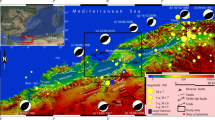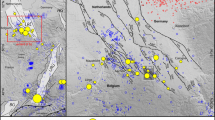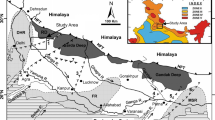Abstract
A pre-rift Upper Cretaceous succession records evidence of a localized liquefaction at the eastern side of the Gulf of Suez rift, Egypt. Structurally controlled clastic intrusions, slump-like folds and megabreccia are the common liquefaction-induced structures. The sandstone dykes taper upward with no exposed feeder, and are oriented parallel to and along rift-related conjugate normal faults. The slumps are localized, spatially related to rift-related faults, and preserved within mudstone-dominated layers with more competent sandy shale interbeds. The megabreccias are chaotic, and stretched sporadically along the footwall of a rift-related fault. Meteorite impact, explosive volcanicity, and storm wave actions are excluded as trigger mechanisms. Recent and paleo-earthquake records show that the Neogene Gulf of Suez rift is a seismically active belt with a southward increase in seismic activity. Tectonic-related seismic activity is suggested as a plausible trigger for the liquefaction. Movement along rift-related faults during Oligo-Miocene times might have triggered earthquakes that produced the paleo-seismites.









Similar content being viewed by others
Data availability statement
The authors confirm that the data supporting the findings of this study are available within the article.
References
Abdallah AM, Adindani A, Fahmy N (1963) Stratigraphy of Lower Mesozoic rocks, western side of the Gulf of Suez. Geol Surv Egypt Paper No. 27, 23p
Abdel Gawad GI (1999) Biostratigraphy and macrofossil assemblages of the Matulla Formation (Coniacian-Santonian), west central Sinai, Egypt. Middle East Research Center, Ain Shams University. Cairo Earth Sci Ser 13:187–202
Abdel Rahaman M, Tealeb A, Mohamed A, Deif A, Abou Elenean K, El-Hadidy MS (2008) Seismotectonic zones at Sinai and its surrounding. In: First Arab Conference on Astronomy and Geophysics, Helwan, Egypt, pp 20–22
Abdelazim M, Samir A, Abu El-Nader I, Badawy A, Hussein H (2016) Seismicity and focal mechanisms of earthquakes in Egypt from 2004 to 2011. NRIAG J Astron Geophys 5:393–402
Abdel-Fattah AK, Hussein HM, Ibrahim EM, Abu El Atta AS (1997) Fault plane solutions of the 1993 and 1995 Gulf of Aqaba earthquakes and their tectonic implications. Ann Geofis 40:1555–1564
Abdel-Rahman K, Al-Amri AMS, Abdel-Moneim E (2009) Seismicity of Sinai Peninsula. Egypt Arab J Geosci 2:103–118. https://doi.org/10.1007/s12517-008-0014-0
Abdulnaby W (2019) Structural geology and neotectonics of Iraq, Northwest Zagros. In: Saein AF (ed) Developments in Structural Geology and Tectonics, Elsevier, Amsterdam, pp 53–73. https://doi.org/10.1016/B978-0-12-815048-1.00004-4
Abou Elenean KM (2007) Focal mechanisms of small and moderate size earthquakes recorded by the Egyptian National Seismic Network (ENSN). Egypt NRIAG J Geophys 6(1):117–151
Abou Elenean K, Hussien HM (2008) The October 11, 1999 and November 08, 2006 Beni Suef earthquakes. Pure Appl Geophys 165:1391–1410
Abu Khadra AM, Youssef EAA, Refaat A (1990) Depositional environments and diagenesis of the Matulla Formation, Abu Zenima area, West-Central Sinai. Egypt Bull Fac Sci 58:493–513
Abu Sharib ASAA, Selim AQ, Abdel Fattah MM, Hassan SM, Sanislav IV (2019) Thermal alteration of organic matter in the contact of a rift-related basaltic dyke: an example from the black limestone Wadi Matulla, West Central Sinai, Egypt. Minerals 9:279. https://doi.org/10.3390/min9050279
Abuo El-Ela A, Mohamed E-H, Deif A, Abou Elenean K (2012) Seismic hazard studies in Egypt. NRIAG J Astron Geophys 1:119–140
Agnon A, Migowski C, Marco S, (2006) Intraclast breccias in laminated sequences reviewed: recorders of paleoearthquakes. In: Enzel Y, Agnon A, Stein M (eds) Frontiers in Dead Sea Paleoenvironmental Research, GSA Special Paper, 401, pp. 195–214.
Allen JRL (1984) Sedimentary Structures, Their Character and Physical Basis. Elsevier, Amsterdam, pp 343–663
Alsop IG, Marco S (2013) Seismogenic slump folds formed by gravity-driven tectonics down a negligible subaqueous slope. Tectonophysics 605:48–69
Ambraseys NN, Melville CP, Adams RD (1994) The seismicity of Egypt Arabia and Red Sea. Cambridge University Press, Cambridge, p 182
Archer JB (1984) Clastic intrusions in deep-sea fan deposits of the Rosroe formation, Lower Ordovician, Western Ireland. J Sediment Petrol 54:1197–1205
Badawy A (1998) Earthquake hazard analysis in northern Egypt. Acta Geodaetica Et Geophysica Hungarica 33(2):341–357
Badawy A (2005) Present-day seismicity, stress field and crustal deformation of Egypt. J Seismol. https://doi.org/10.1007/s10950-005-2190-7
Barakat MG, Darwish M, El Outefi NS (1988) Eocene tectonostratigraphy and basin evaluation in the Gulf of Suez petroliferous province. In Proceedings of the 9th Egyptian General Petroleum Corporation, Petroleum Exploration and Production Conference, Cairo, Egypt, 1: 1–22.
Bastesen E, Rotevatn A (2012) Evolution and structural style of relay zones in layered limestone–shale sequences: insights from the Hammam Faraun Fault Block, Suez rift Egypt. J Geol Soc Lond 169:477–488
Ben-Avraham Z, Garfunkel Z, Almagor G, Hall JK (1979) Continental breakup by a leaky transform: the Gulf of Elat (Aqaba). Science 206:214–216
Ben-Menahem A, Aboodi E (1971) Tectonic Patterns in the Northern Red Sea Region. J Geophys Res 76(11):2674–2689
Ben-Menahem A, Mur A, Vered M (1976) Tectonics, seismicity, and structure of the Afro-Eurasian junction the breaking of an incoherent plate. Phys Earth Planet Inter 12:1–50
Ben-Menahem, A., 1979. Earthquake catalog for the Middle East (92 B.C.-1980 A.D.) Boll Geofis Tear Appl 21:245–310
Bhattacharya B, Bhattacharjee J, Banerjee S, Bandyopadhyay S, Das R (2016) Seismites in Permian Barakar Formation, Raniganj Basin, India: implications on Lower Gondwana basin evolution. Arab J Geosci 9:300. https://doi.org/10.1007/s12517-016-2318-9
Bosworth W (2015) Geological evolution of the Red Sea: historical background, review, and synthesis. In: Rasul NMA, Stewart ICF (eds) The Red Sea. Springer Earth System Sciences, Berlin, pp 45–78
Bosworth W, Montagna P, Pons-Branchu E, Rasul N, Taviani M (2017) Seismic Hazards Implications of Uplifted Pleistocene Coral Terraces in the Gulf of Aqaba. Scientific Rep. https://doi.org/10.1038/s41598-017-00074-2
Bosworth W, McClay KR (2001) Structural and stratigraphic evolution of the Gulf of Suez rift, Egypt: A synthesis. In: Zeigler PA, Cavazza W, Robertson AHFR, Crasquin-Soleau S (eds) Peri-Tethys Memoir 6: ‘Peri-Tethyan Rift/Wrench Basins and Passive Margins’. Mémoires du Museum National d’Historie Naturelle de Paris 186:567–606
Calvo JP, Rodríguez-Pascua M, Martín-Velázquez S, Jiménez S, de Vicente G (1998) Microdeformation of lacustrine laminite sequences from Late Miocene formations of SE Spain: an interpretation of loop bedding. Sedimentology 45:279–292
Chang A, Grimm KA (1999) Speckled beds: distinctive gravity-flow deposits in finely laminated diatomaceous sediments, Miocene Monterey Formation, California. J Sediment Res 69:122–134
Childs C, Manzocchi T, Walsh JJ, Bonson CG, Nicol A, Schöpfer MPJ (2009) A geometric model of fault zone and fault rock thickness variations. J Struct Geol 31:117–127
Chong WL, Haque A, Gamage RP, Shahinuzzaman A (2013) Modelling of intact and jointed mudstone samples under uniaxial and triaxial compression. Arab J Geosci 6:1639–1646. https://doi.org/10.1007/s12517-011-0463-8
Courtillot V, Armijo R, Tapponnier P (1987) The Sinai triple junction revisited. Tectonophysics 141(1–3):181–190
Daggett P, Morgan P, Boulous F, Hennin S, El-Sherif A, El-Sayed A, Basta N, Melek Y (1986) Seismicity and active tectonics of the Egyptian Red Sea margin and the northern Red Sea. Tectonophysics 125:313–324
Dechen S, Aiping S (2012) Typical earthquake-induced soft-sediment deformation structures in the Mesoproterozoic Wumishan Formation, Yongding River Valley, Beijing, China and interpreted earthquake frequency. J Paleogeog 1(1):79–89. https://doi.org/10.3724/SP.J.1261.2012.00007
El-Barkooky AN, El-Araby A (1998) The Tertiary Red Beds of Abu Zenima area, West Central Sinai, Egypt: Their Stratigraphy and Sedimentology. In: Proceedings of the 4th Geology of the Arab World, Cairo University, Cairo, Egypt, pp 621–642.
Elhossainy MM, Salman AM, Sarhan MA, Al-Areeq NM, Alrefaee HA (2021) Sequence stratigraphic analysis and depositional evolution of the Upper Cretaceous deposits in Ras Budran oil field, Gulf of Suez, Egypt. Arab J Geosci. https://doi.org/10.1007/s12517-021-07470-z
Fossen H, Rotevatn A (2016) Fault linkage and relay structures in extensional settings—A review. Earth Sci Rev 154:14–28
Garfunkel Z (1981) Internal structure of the Dead Sea leaky transform (rift) in relation to plate kinematics. Tectonophysics 80:81–108
Gawthorpe RL, Hurst JM (1993) Transfer zones in extensional basins: their structural style and influence on drainage development and stratigraphy. J Geol Soc London 150:1137–1152
Gergawi A, El-Khashab H (1968) Seismicity of U.A.R. Helwan Observatory Bulletin No. 76
Grimm KA, Orange DL (1997) Synsedimentary fracturing, fluid migration, and subaqueous mass wasting; intrastratal microfractured zones in laminated diatomaceous sediments, Miocene Monterey Formation, California, USA. J Sediment Res 67:601–613
Gutenberg B, Richter CF (1954) Seismicity of the earth and associated phenomena, 2nd edn. Princeton University Press, Princeton, NJ
Hassan HF, Abouelresh MO (2016) Characteristics of Campanian-Maastrichtian Sudr chalk, Gabal El-Bruk, North Sinai Egypt J. Petrol Min 18(1):27–38
He B, Qiao X, Zhang Y, Tian H, Cai Z, Chen S, Zhang Y (2014a) Soft-sediment deformation structures in the Cretaceous Zhucheng Depression, Shandong Province, East China; their character, deformation timing and tectonic implication. J Asian Earth Sci. https://doi.org/10.1016/j.jseaes.2014.12.005
He B, Qiao X, Jiao C, Xu Z, Cai Z, Guo X, Zhang Y (2014b) Palaeo-earthquake events during the late Early Palaeozoic in the central Tarim Basin (NW China): evidence from deep drilling cores. Geologos 20(2):105–123
Hippertt JP, Lana C, Weinberg RF, Tohver E, Schmieder M, Scholz R, Gonçalves L, Hippertt JF (2014) Liquefaction of sedimentary rocks during impact crater development. Earth Planet Sci Letters 408:285–295
Huang S, Wang J, Qiu Z, Kang K (2018) Effects of cyclic wetting-drying conditions on elastic modulus and compressive strength of sandstone and mudstone. Processes 6:234. https://doi.org/10.3390/pr6120234
Ismail A (1960) Near and local earthquakes of Helwan (1903-1950). Helwan Observatory Bulletin. J Seismol 9(3):267–276
Jackson CAL, Gawthorpe RL, Leppard CW, Sharp IR (2006) Rift initiation development of normal fault blocks: insights from the Hammam Faraun fault zone block, Suez Rift, Egypt. J Geol Soc Lond 163:165–183
Joffe S, Garfunkel Z (1987) Plate kinematics of the Circum Red Sea—a re-evaluation. Tectonophysics 141:5–22
Jolly RJH, Lonergan L (2002) Mechanisms and controls on the formation of sand intrusions. J Geol Soc London 159:605–617
Kebeasy RM (1990) Seismicity of Egypt. In: Said R (ed) Geology of Egypt. Balkema, Rotterdam, pp 51–59
Khalil SM, McClay K (2001) Tectonic evolution of the NW Red Sea-Gulf of Suez rift system. Geol Soc Lond, Spec Publ 187(1):453–473
Lewis CJ, Gardner JN, Schultz-Fellenz ES, Lavine A, Reneau SL, Olig S (2009) Fault interaction and along-strike variation in throw in the Pajarito fault system, Rio Grande rift, New Mexico. Geosphere 5(3):252–269
Liang D, Song Z, Zhao C, Nie Z (2002) Discovery of Mesoproterozoic seismites at Baishi Mountain, Hebei Province and its geological significance. Geol Bull China 21:625–630 (<Emphasis Type="Bold">(in Chinese with English abstract)</Emphasis>)
Lowe DR (1976) Subaqueous liquefied and fluidized sediment flows and their deposits. Sedimentology 23:285–308
Lowe DR (1979) Sediment gravity flows: their classification, and some problems of application to natural flows and deposits. In: Doyle LJ, Pilkey OH (eds) Geology of Continental Slopes. SEPM Special Publication, Tulsa, pp 75–82
Maamoun M, Megahed A, Allam A (1984) Seismicity of Egypt. Bull Helwan Instit Astron Geophysics 4:109–160
Maltman A, Bolton A (2003) How sediment become mobilized. Geol Soc London Spec Publ 216(1):9–20
Martín-Chivelet J, Palma RM, López-Gómez J, Kietzmann DA (2011) Earthquake-induced soft-sediment deformation structures in Upper Jurassic open-marine microbialites (Neuquén Basin, Argentina). Sed Geol 235:210–221
Meghraoui M, Gomez F, Sbeinati R, Van der Woerd J, Mouty M, Darkal AN, Radwan Y (2003) Evidence for 830 years of seismic quiescence from palaeoseismology, archaeoseismology and historical seismicity along the Dead Sea fault in Syria. Earth Planet Sci Lett 210:35–52
Meneisy MY (1990) Vulcanicity. In: Said R (ed) The Geology of Egypt. Balkema, Rotterdam, pp 157–172
Mohamed AA, El-Hadidy M, Deif A, Abou Elenean K (2012) Seismic hazard studies in Egypt. NRIAG J Astron Geophys 1(2):119–140
Mohamed EK, Hassoup A, Abou Elenean KM, Othman AAA, Hamed DMK (2015) Earthquakes focal mechanism and stress field pattern in the northeastern part of Egypt. NRIAG J Astron Geophys 4(2):205–221
Moretti M, Sabato L (2007) Recognition of trigger mechanisms for soft-sediment deformation in the Pleistocene lacustrine deposits of the SantʻArcangelo Basin (Southern Italy): seismic shock vs. overloading. Sedimen Geol 196:31–45
Moustafa AM (1976) Block faulting of the Gulf of Suez. In Proceedings of the 5th Exploration Seminar, Egyptian General Petroleum Company, Cairo, Egypt p. 19.
Moustafa AR, Abdeen MM (1992) Structural setting of the Hamman Faraoun block, eastern side of the Suez rift. J Univer Kuweit (science) 19:291–309
Moustafa AR, Salama ME, Khalil SM, Fouda HGA (2013) Sinai hinge belt: a major crustal boundary in NE Africa. J Geol Soc London. https://doi.org/10.1144/jgs2013-021
Müller K, Winsemann J, Pisarska-Jamroży M, Lege T, Spies T, Brandes C (2021) The challenge to distinguish soft-sediment deformation structures (SSDS) formed by glaciotectonic, periglacial and seismic processes in a formerly glaciated area: a review and synthesis. In: Steffen H, Olesen O, Sutinen R (eds) Glacially-Triggered Faulting. Cambridge University Press, Cambridge, pp 67–88
Nichols RJ (1995) The liquification and remobilization of sandy sediment. In Hartley AJ, Prosser DJ (eds) Characterization of Deep Marine Clastic Systems, Geological Society Special Publication 94, pp. 63–76
Obermeier SF (1996) Use of liquefaction-induced features for paleoseismic analysis - an overview of how seismic liquefaction features can be distinguished from other features and how their regional distribution and properties of source sediment can be used to infer the location and strength of Holocene paleo-earthquakes. Engineer Geol 44:1–76
Owen G, Moretti M, Alfaro P (2011) Recognising triggers for soft-sediment deformation: current understanding and future directions. Sedimen Geol 235:133–140
Paillou P, El Barkooky A, Barakat A, Malezieux JM, Beynard B, Dejax J, Heggy E (2004) Discovery of the largest impact crater field on Earth in the Gilf Kebir region. Egypt c r Geoscience 336:1491–1500
Palladino G, Alsop GI, Grippa A, Seers T, Hurst A (2018) Sandstone intrusions along different types of faults and their effect on fluid flow in siliciclastic reservoir. In: Silcock S, Huuse M, Bowman M, Hurst A, Cobain S (eds) Subsurface Sand Remobilization and Injection. Geol Soc London, Special Publications 493(1):273. https://doi.org/10.1144/SP493-2018-45
Pankow KL, Moore JR, Hale JM, Koper KD, Kubacki T, Whidden KM, McCarter MK (2014) Massive landslide at Utah copper mine generates wealth of geophysical data. GSA Today 24(1):9
Patton TL, Moustafa AR, Nelson RA, Abdine SA (1994) Tectonic evolution and structural setting of the Suez Rift. In: Landon SM (ed) Interior Rift Basins. AAPG Memoir 59:7–55.
Perrin C, Manighetti I, Gaudemer Y (2016) Off-fault tip splay networks: A genetic and generic property of faults indicative of their long-term propagation. C r Geosci 348:52–60. https://doi.org/10.1016/j.crte.2015.05.002
Poirier JP, Taher MA (1980) Historical seismicity in the Near and Middle East, North Africa and Spain from Arabic documents (VIIth–XVIIth century). Bull Seismol Soc Am 70:2185–2201
Rogers JJW, Mohamed AG, Richard MN, Jeffrey KG, Paul DF (1978) Plutonism in Pan-African belts and the geologic evolution of northeastern Africa. Earth Planet Sci Lett 39(1):109–117
Rudersdorf A, Hartmann K, Yu K, Stauch G, Reicherter K (2015) Seismites as indicators for Holocene seismicity in the northeastern Ejina Basin, Inner Mongolia. In: Landgraf A, Kuebler S, Hintersberger E, Stein S (eds) Seismicity, Fault Rupture and Earthquake Hazards in Slowly Deforming Regions, Geological Society. Special Publications, London
Salamon A, Hofstetter A, Garfunkel Z, Ron H (2003) Seismotectonics of the Sinai subplate – the eastern Mediterranean region. Geophys J Int 155:149–173
Seed HB, Idriss IM (1982) Ground motions and soil liquefaction during earthquakes. Earthquake Engineering Research Institute, Berkeley, California, p 134
Seilacher A (1969) Fault-Graded Beds Interpreted as Seismites. Sedimentol 13:155–159
Shallaly NA, Beier C, Haase KM, Hammed MS (2013) Petrology and geochemistry of the Tertiary Suez rift volcanism, Sinai, Egypt. J Volcan Geother Res 267:119–137
Shanmugam G (2015) The Landslide Problem. J Palaeogeogr 4(2):109–166
Shanmugam G (2016) The Seismite Problem. J Palaeogeogr 5(4):318–362
Shanmugam G (2017) The fallacy of interpreting SSDS with different types of breccias as seismites amid the multifarious origins of earthquakes: implications. J Palaeogeog. https://doi.org/10.1016/j.jop.2016.09.001
Shi C, Ding Z, Lei M, Peng L (2013) Accumulated deformation behavior and computational model of water-rich mudstone under cyclic loading. Rock mechanics and rock engineering (ISSN 0723-2632). https://doi.org/10.1007/s00603-013-0427-2
Smyers NB, Peterson GL (1971) Sandstone dikes and sills in the Moreno Shale, Panoche Hills, California. Geol Soc America Bull 82:3201–3208
Sieberg A (1932) Handbuck der Geophysik, Band IV, Erdbebengeographie, Borntraeger, Berlin, pp 527–1005
Stewart KG, Dennison JM, Bartholomew MJ (2002) Late Mississippian paleoseismites from southeastern West Virginia and southwestern Virginia. Geol Soc America Special Paper 359.
Surpless KD, Ward RB, Graham SA (2009) Evolution and stratigraphic architecture of marine slope gully complexes: Monterey Formation (Miocene), Gaviota Beach, California. Mar Pet Geol 26:269–288
Tappin DR (2004) Submarine Slump-Generated Tsunamis. Marine Geol 203:199–200
Van Loon AJ (2009) Soft-sediment deformation structures in siliciclastic sediments: an overview. Geologos 15:3–55
Wibberley CAJ, Yieding G, Toro GD (2008) Recent advances in the understanding of fault zone internal structure: a review. In: Wibberley CAJ, Kurz W, Imber J, Holdsworth RE, Collettini C (eds) The Internal Structure of Fault Zones: Implications for Mechanical and Fluid-Flow Properties. The Geological Society of London, London, pp 5–33
Woodcock NH, Mort K (2008) Classification of fault breccias and related fault rocks. Geol Mag 145(3):435–440. https://doi.org/10.1017/S0016756808004883
Yang CM, Kang KH, Yang SH, Li KW, Wang HJ, Lee YT, Lin KK, Pan YW, Liao JJ (2020) Large paleo-rockslide induced by buckling failure at Jiasian in Southern Taiwan. Landslides. https://doi.org/10.1007/s10346-020-01360-3
Young MJ, Gawthorpe RL, Sharp IR (2003) Normal fault growth and early syn-rift sedimentology and sequence stratigraphy: Thal Fault, Suez Rift. Egypt Basin Research 15:479–502
Zhang Z, Wang T, Wu S, Tang H, Liang C (2017) The role of seismic triggering in a deep-seated mudstone landslide, China: Historical reconstruction and mechanism analysis. Eng Geol 226:122–135
Author information
Authors and Affiliations
Corresponding author
Ethics declarations
Conflict of interest
The authors whose names are listed immediately below certify that they have NO affiliations with or involvement in any organization or entity with any financial interest (such as honoraria; educational grants; participation in speakers’ bureaus; membership, employment, consultancies, stock ownership, or other equity interest; and expert testimony or patent-licensing arrangements), or non-financial interest (such as personal or professional relationships, affiliations, knowledge or beliefs) in the subject matter or materials discussed in this manuscript.
Rights and permissions
Springer Nature or its licensor (e.g. a society or other partner) holds exclusive rights to this article under a publishing agreement with the author(s) or other rightsholder(s); author self-archiving of the accepted manuscript version of this article is solely governed by the terms of such publishing agreement and applicable law.
About this article
Cite this article
Abdel Fattah, M.M., Abu Sharib, A.S.A.A. Liquefaction-induced structures, Hammam Faroun Block, Gulf of Suez rift, Egypt: possible rift-related Neogene seismites. Int J Earth Sci (Geol Rundsch) 112, 1113–1131 (2023). https://doi.org/10.1007/s00531-023-02289-3
Received:
Accepted:
Published:
Issue Date:
DOI: https://doi.org/10.1007/s00531-023-02289-3




